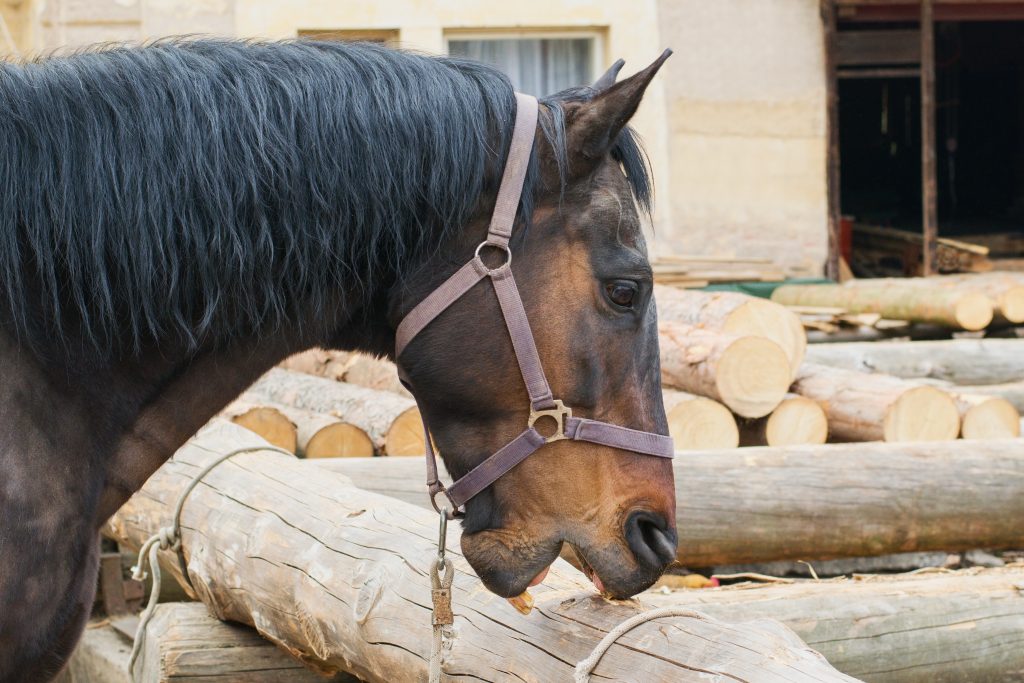Dr David Wood BVSc, MRCVS
Stereotypic behaviors are abnormal repetitive, purposeless behaviors with no useful function which often point to welfare issues. They occur both outdoors at pasture and inside when they were traditionally called stable vices.
Outdoor examples include bark and wood chewing, dirt licking/eating, pawing the ground, pacing fence lines, tail chewing, wind sucking and crib biting. In stables, wind sucking, crib biting, nodding, and weaving, head shaking, stall walking and eating bedding are the most prevalent stereotypies. A survey by Van den Berg et al in 2014 included responses from 497 Australian horse owners and covered 3083 horses kept at least partly outside at pasture. Roughly 45% of those horses showed some stereotypic behavior with bark chewing the most common at 26% and crib biting rare at only 1%. 95% of these horses were being fed concentrates and/or supplements as well as pasture.
Conversely, a 2002 UK study by Waters et al had 30% of young horses wood chewing and a whopping 10.5% showing crib biting. Clearly, the problems are not limited to stabled horses and some of them, like chewing bark or tail biting, may be a part of the normal behavioral pattern of horses – just because we find eating dirt to be peculiar does not mean that horses do.

Broadly speaking we can separate these traits into two categories, oral or feeding related and locomotory or related to movement.
LOCOMOTORY
- Stall / fence walking
- Weaving and nodding
- Digging / pawing the ground
These are possibly more related to confinement, frustration and advance anticipation of stimuli like feeding.
ORAL
- Wind sucking +/- crib biting
- Wood chewing, dung or bark eating
- Tail / mane chewing
Likely to be either part of normal behavior or stress, diet, nutrition and feeding management related.
Surveys of these behaviors span several countries, breeds of horse, and age groups and not surprisingly estimates of how commonly they occur vary widely. The age at which they begin also varies but the survey by Waters mentioned above found a mean age for crib biting of 20 weeks and 30 weeks for wood chewing. The fact that this is around the time of weaning may be no coincidence.
One of the most pernicious on the list of stereotypies is crib biting where the horse grasps an object with its front teeth then retracts the muscles of the upper neck pulling back the larynx and aspirating air into the upper part of the oesophagus. This is ‘’wind sucking’’ and produces a characteristic grunt. Horses can also learn to wind suck without the need to crib bite onto a fixed object.

In some horses this aberrant behavior may come to dominate. One study of affected Thoroughbred geldings estimated they cribbed an average of 1,470 times daily whilst stabled. Results can include dental damage, certain types of colic, unthriftiness and injury to the hyoid apparatus which supports the larynx. Crib biting is unknown in wild free living or feral horses but once brought into captivity it will show up. Something about the captive environment, feed or feed management must logically be a causal factor.
In stables, feeding time is limited to two or three short periods per day but when provided with ad lib forage feeds such as hay, mares will spend 60% of their time eating. The ability to move around and socialize with other horses is also curtailed by stabling and the diet often changes from low energy fibrous forages to include some high energy concentrates. This change in diet may frustrate the natural drive to graze, compounded by the inability to exercise and socialize normally by foraging in groups. Cause and effect however is extremely difficult to establish.
The abrupt weaning of foals significantly increases the incidence of crib biting. Lack of access to milk and separation stress render the foal more likely to have an empty stomach which in turn increases acidity and the likelihood of stomach ulceration. One theory suggests that crib biting and wood chewing is a response aimed at stimulating extra saliva production, which buffers stomach acidity and helps relieve stomach discomfort. Cribbing often begins at or soon after weaning though some pre weaned foals will crib, prompting the suggestion that their behavior is learned from the dam. Crib biting foals do show more stomach inflammation than normal foals, and feeding antacids tends to reduce stomach acidity and lessen cribbing. Possibly the additional saliva produced during cribbing coupled with its acid buffering effect may be doing the same thing.

Further evidence to support this comes from the rate of cribbing which increases after feeding, peaking 4-8 hours after meal delivery. The anticipation of discomfort caused by eating can be learned and was shown in one study to increase the rate of cribbing by up to sixteen times within ten minutes of providing a small concentrate meal. It seems these horses were actually cribbing to prevent the onset of stomachache.
The link between crib biting and gut function may extend to the gut microflora too. Crib biters tend to have a characteristic hind gut microbiome, distinct from the normal horse populace. The difference may be related to higher acid levels in the gut of affected horses which in turn links to ulceration and discomfort. Ultimately, concentrate feeding is the likely predisposing factor through lowering pH in both the stomach and the hind gut. It seems likely that the gut changes are a cause of, rather than a result of the crib biting behavior. Gut pH and the gut microbiome are increasingly being seen as influencing equine behavior through both the autonomic nervous system and hormones.
In nature things which happen commonly across many individuals rarely do so with no reason or purpose. It is interesting to speculate that crib biting may not truly be a purposeless stereotypic behavior at all but could actually be a response designed to alleviate the discomfort caused by an acid stomach and ulceration.
On a different tack entirely another group of researchers led by Dr Arash Omidi from the University of Shiraz in Iran, have established a link between crib biting and low Selenium (Se) levels in affected horses. They measured several blood parameters including trace elements, electrolytes and hormones and discovered consistently low selenium levels in the cribbing group as compared to the normal control group. The lowest serum Se levels were seen when horses were actively cribbing. As selenium plays a critical role in the function of antioxidants like Vitamin E, they proposed that oxidative stress may be involved in this behavior. The investigation was prompted in part by similar findings in humans where low selenium has been linked to some instances of schizophrenia and autism.

This is a remarkable piece of work and provides the first solid evidence linking a stereotypic behavior to a specific nutrient deficiency in the horse.
Whilst no definitive treatment, let alone a cure for crib biting has been found, it seems clearer now that the previously used restraint devices like throat collars and neck braces designed to physically deter the activity are far from ideal and do nothing to alleviate the cause. Using bitter or chili pastes and paints on fences etc. is similarly unhelpful, but what can we do with a cribbing horse?
The selenium story might offer potential for providing a treatment option, though the researchers have not endorsed that idea yet, rightly suggesting that further research is needed first. Selenium supplementation is not without risk as the element is toxic if overdosed. The recommended intake is 0.1mg Se per kg of dry matter of feed, equivalent to about 1.0mg per day for a 500kg adult horse. Some authors suggest levels up to 2-3 times this are safe and may improve immune function.
The upper limit for safety is regarded as 2.0 mg Se per kg dry matter of feed, but it would be unwise and unnecessary to exceed 0.5mg per kg DM of feed. Injectable preparations of selenium with Vitamin E are risky in horses and should be treated with caution. The selenium intake from all sources should be accounted for when calculating any intended supplementation. Several parts of Australia have selenium deficient soils and pastures, and since locally sourced hays may also be deficient, supplementation is quite often appropriate. Manufactured feeds generally include Se but if crib biting is an issue then total Se intake and status should be evaluated and cautious supplementation used as needed. Vitamin E intake should also be assessed and adjusted if need be and whilst no treatment or cure is implied the correction of any nutrient deficiencies is always beneficial.
The attitude of horsemen to crib biting horses tends to range from dismissive to downright hostile and the cribbing horse is universally perceived in a negative light. Perhaps an understanding that these horses may be doing this to alleviate pain or discomfort in the gut, or some form of emotional or psychological distress, might help owners towards useful interventions by way of treatment.
If wild free ranging horses do not crib, then surely this provides some clue as to how the behavior could be managed. Turning horses out into paddocks with other horses and boosting forage intake at the expense of concentrates would be a logical start. Where that is impractical for working horses in stables then at least some partial dietary changes to boost fiber intake and switch some starch energy to oil- based energy sources would be worth trying. Access to pasture, selenium supplementation if appropriate, the use of antacids like sodium carbonate or ulcer treatments like omeprazole combined with probiotics and prebiotics to support gut health may be worthwhile but there are no guarantees just yet.
Crib biting, like the other stereotypic behaviors is really a man-made problem reflecting the stress we put on horses by domesticating and using them. By enforcing unnatural feeding patterns, social isolation, and restriction of movement we surely must be driving some stress related reactions – and that’s before we even put a saddle and bridle anywhere near them. A severely disturbed autistic child compulsively rocking its head in the corner would surely provoke our sympathy, perhaps the crib biting horse should too.
References.
Potential role for selenium in the pathophysiology of crib-biting behavior in horses. Arash Omidi et al. J Vet Behavoir 23 Jan- Feb 2018 pp10-14
Potential roles of Selenium and Zinc in the pathophysiology of crib-biting behavior in horses. Arash Omidi et al. J Vet Behavoir Clinical Applications and Research 23 Oct 2017
Relative Occurrence of Stereotypic Type Behaviours in Pastured Horses in Australia. M Van den Berg et al. Proc. Australasian Equine Sc. Symp. Vol 5 2014
Equine Applied & Clinical Nutrition. Geor, Harris & Coenen 2013 ISBN 978-0-7020-3422-0
National Research Council Nutrient Requirements of Horses 6th Ed 2007

